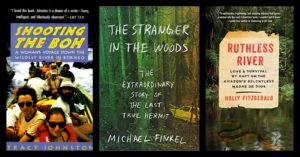Stories of survival fill me with shivery delight. I rarely meet a story of man/woman/elements that doesn’t keep me up till all hours—it’s no doubt one of my favorite sub-genres. Below are two recent entries into my hall of fame, along with an evergreen selection.
I practically leapt into my car to buy Ruthless River at Brookline Booksmith after reading of its release. I’d met the author, Holly Fitzgerald, before the book launch, and hearing her tale of “The ultimate survival story; a wild ride–the wildest–down a South American river in the thick of the Amazon Basin; a true and thrilling adventure of a young married couple who survive a plane crash only to later raft hundreds of miles across Peru and Bolivia, ending up in a channel to nowhere, a dead end so flooded there is literally no land to stand on. Their raft–a mere four logs–separates them from the piranha-and-caiman-infested water until they finally realize that there is no way out but to swim,†had me at hello.
To say this book gripped me is a huge degree of understatement.
When browsing bookstores, my rule is ‘look for a book where I am unfamiliar with the author/book, letting the cover/story/description grab me.’ Last month, in Belmont Bookstore I discovered The Stranger in The Woods by Chris Woods, “In 1986, a shy and intelligent twenty-year-old named Christopher Knight left his home in Massachusetts, drove to Maine, and disappeared into the forest. He would not have a conversation with another human being until nearly three decades later, when he was arrested for stealing food. Living in a tent even through brutal winters, he had survived by his wits and courage, developing ingenious ways to store edibles and water, and to avoid freezing to death. He broke into nearby cottages for food, clothing, reading material, and other provisions, taking only what he needed but terrifying a community never able to solve the mysterious burglaries. Based on extensive interviews with Knight himself, this is a vividly detailed account of his secluded life–why did he leave? what did he learn? –as well as the challenges he has faced since returning to the world. It is a gripping story of survival that asks fundamental questions about solitude, community, and what makes a good life, and a deeply moving portrait of a man who was determined to live his own way, and succeeded.â€
I read Shooting the Boh: A Woman’s Journey Down the Wildest River in Borneo by Tracy Johnston quite a few years ago and have been urging folks to read it ever since. Publishers Weekly reviewed it thusly: This story of a journalist joining an expedition down the Boh River starts out as standard adventure travel fare, but the difference rapidly becomes apparent: this journalist is over 40, her luggage is lost on the flight over and cannot be recovered in time, and the expedition has been planned by a company that takes irresponsibility to a new level. Only when they are already on the river do the participants realize how difficult and dangerous their time together will be. All of them must deal with “insect stress” caused by bees that feast on human sweat, foot fungus, raging rapids, and perhaps an evil river spirit. On top of that, Johnston begins to have menopausal hot flashes and questions whether it is time to give up the thrill of risky journeys. Her descriptions of both natural phenomena and local customs are lyrical: she compares salespeople in an outdoor market to “baby birds, mouths open, arms aflutter.” In writing about the seemingly cursed journey, Johnston keeps her chin up and sticks to what she calls “the adventure code of travel: go with the unexpected and make do with what you get.”
Just writing about this book, I visit my bookshelves so I can reread Shooting the Boh.
